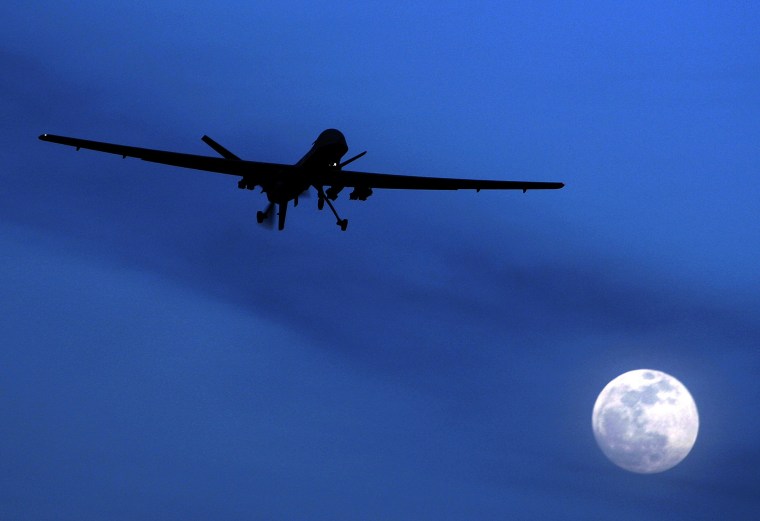More than a decade after the tragedy of 9/11, it appears that some of the most fundamental aspects of how we combat al-Qa’ida are poised to change.
One of those changes might involve drones. The Obama administration reportedly plans to move responsibility for operating lethal drones from the CIA to the Pentagon. The move will lead to important changes, but critics of drone policy may be disappointed.
The CIA operates covertly—meaning that its operations can be denied by government officials. But the Joint Special Operations Command within the Department of Defense operates clandestinely, which means its operations are also secret and not openly acknowledged. Thus, even if the reported change occurs, the public shouldn’t expect to see Pentagon press conferences about drone operations.
Nor will the shift to the Defense Department produce vast differences in congressional oversight. In fact, since Watergate and the Iran-Contra Affair, CIA covert action has required explicit congressional notification and briefings. Congress conducts intensive oversight of Defense Department operations, but in many ways these are less intrusive than that of covert action. Congress can of course require additional information on these operations, but it is doubtful that any oversight will be significantly greater than that of covert action today.
The reported shift would have real effects on three points: (1) making clear the legal restrictions on drone usage; (2) returning to a more traditional balance between the CIA and Pentagon; (3) and providing an opportunity for more open operations where necessary.
Although the CIA has said that it conducts strikes consistent with the laws of armed conflict, a shift to the Pentagon will make far more clear, domestically and internationally, that such strikes are legally bound by international laws of armed conflict. This is a good thing, as it should bring greater legitimacy to U.S. efforts—a critical element in maintaining strong counterterrorism partnerships.
Such a shift will also move the United States to a more traditional balance between the CIA and Defense. The spy agency has always been responsible for covert action, but the past 10 years have been a historical anomaly in terms of the size and scope of its lethal targeting. And while the CIA carried out this mission brilliantly, and undoubtedly saved American lives in the process, it arguable came at a cost to the agency’s more traditional role of strategic intelligence collection and analysis. Moreover, the rather comical openness with which the drone program has recently operated has run the risk of cheapening the covertness of truly sensitive covert action programs that must be kept very much in the shadows. A shift of the program to the Department of Defense—assuming Defense can apply the same rigorous targeting process (something I am quite confident it can)—will, over time, address both of these issues.
Finally, the move to the Department of Defense will make it easier for the United States to push our allies to be more open supporters of the tactics for which they today privately plead. Because the U.S. does not claim responsibility for strikes, it has allowed other governments to publicly condemn actions which they privately support. Although it won’t be easy to change this now-entrenched dynamic, ultimately we must ensure that the nations in which we operate are openly on our side, lest their citizens view American actions as unilateral and at war with their societies. In short, we need to ensure that the governments in places like Pakistan, Yemen, and elsewhere stand next to us and say that our targeting is helping keep those nations safe and secure.
The shift on drones should lead lawmakers to consider other changes as well, specifically to the post-9/11 Authorization for Use of Military Force. The AUMF has served us well, but its direct linkage to 9/11 and the al-Qa’ida of 2001 is increasingly removed from the enemies we face today, as the recent attacks in North Africa illustrate. As a result, the AUMF both lacks legitimacy and could potentially hamper the U.S. executive branch from taking action when threats emanate from organizations that aren’t closely tied to al-Qa’ida.
The president must have significant operational flexibility to use force to protect the nation against terrorists. Congress should play a central role in providing such an updated framework. There will be risks. Once Congress opens a debate on the AUMF, it is exceedingly hard to predict the outcome. But as the drone debate illustrates, we are at a critical juncture and positive congressional involvement brings domestic (and one hopes, international) legitimacy in a way that executive branch action cannot. If we are to have the tools we need to keep the nation safe this debate is a requirement, not a luxury.
More than a decade after 9/11, we have successfully shattered the al-Qa’ida organization, but the threat of terrorism remains (albeit less than what it was). The fight continues, as does the need to evolve our response. These changes and the debate they engender are exactly what we need to keep the nation safe—and to maintain support for the counterterrorism professionals who protect us every day.
